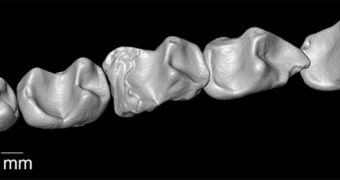Anthropologists and paleontologists are currently puzzled over the discovery of a new primate fossil, which apparently does not fit neatly into the evolutionary tree researchers created thus far. The animal exhibits peculiarities that make it somewhat of a black sheep among other primates. The feature that stands out most is its teeth, which have little in common with those found on other fossils thought to inhabit the same region at the same time, LiveScience reports.
Analysis places the primate as living some 37 million years ago in Africa, and yet no other group of animals exhibiting the same traits has been found in Africa. The new finding is likely to make existing classifications of species living at the time obsolete, and to prompt the revising of some theories. Regardless of how scientists look at the fossils, they simply do not match the existing family tree of species. “It comes as a bit of a shock to find a primate that defies classification,” sums it up expert Erik Seiffert. He was a member of the team that investigated the fossil. The researchers are based at the Stony Brook University, in New York.
The primate species, called Nosmips aenigmaticus, is known only through 12 teeth, which endured long enough to be discovered by scientists. The remains were uncovered in Egypt, and experts say that they are not a part of the groups of species established to have lived in the area 55 million to 34 million years ago. These three major groups are early monkeys, lemur-like creatures, as well as an extinct group called adapiforms. N. aenigmaticus has traits that difference it from all of these animals, Seiffert explains, though the age of its teeth place it in the same area at the same time.
“Nosmips appears to be a highly specialized member of a previously undocumented and presumably quite ancient endemic African primate lineage. When you find the teeth of a fossil primate, it's usually pretty clear where it fits into the family tree. There are only a few species that nobody agrees about and that really can't be placed into any of the major primate groups. These mystery fossils must have something important to tell us about primate evolution,” the expert adds. Additional details of the peculiar fossil will be published in this week's issue of the esteemed journal Proceedings of the National Academy of Sciences (PNAS).

 14 DAY TRIAL //
14 DAY TRIAL //